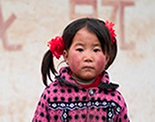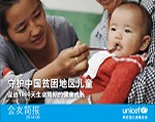How China saved millions of children's and mothers' lives became the celebrated emphasis during a two-day global review of the progress in maternal, newborn and child health in Beijing in October.
“These successes are a clear indication of just how far can be travelled— when a strong commitment and political will is combined with targeted policies that are accompanied by sufficient financing, including an investment in human resources, a willingness to monitor results and adjust, and I would add, the importance shown here in China of a dynamic drive to take that success to scale,” UNICEF China Representative Rana Flowers told the 300 provincial experts from the National Family Planning and Health Commission and the 50 international experts attending the Countdown Meeting on Maternal, Newborn and Child Health.
Richard Horton, Editor of The Lancet, and speaking on behalf of the independent Expert Review Group on Accountability for Women's and Children's Health said China's progress was “unprecedented” and confirmed the enormous contribution it had made in achieving global targets in maternal and child survival and proof that it could be done everywhere.
The rate of decline in mortality among China's children younger than 5 years dropped by 80 per cent, from 79.2 per 1,000 live births in 1991 to 11.7 per 1,000 live births in 2014. Infant mortality dropped to 8.9 per 1,000 live births—a drop of more than 50.2 per 1,000 live births from 1991.
The progress, with an annual reduction rate of 6.9 per cent, led the country to achieve the Millennium Development Goal 4 target of reducing under-5 mortality by three-quarters—eight years ahead of schedule.
Significant progress also was made in reducing the number of women dying during childbirth. In 2014, the maternal mortality rate was 21.7 per 100,000 live births, which was 76 per cent lower than in 1990. This success led China to achieve the Millennium Development Goal 5 a year ahead of the target and narrowed the gap in deaths between rural and urban areas, from 3.4 times greater in rural areas to 2.4 times in 2014.
As highlighted by Director General Qin Geng from the National Family Planning and Health Commission, the success dates back to the 1994 Law on Maternal and Child Health, which was initiated as a result of the UNICEF led 1990 World Summit for Children, signalled the highest level of political commitment. The law opened the way for the provision of maternal and child health services through a service delivery system that tackled both rural and urban challenges.
Financial protection
In the past decade, the emphasis turned to expanding coverage of the country's health insurance scheme, reducing maternal mortality, transmission of HIV, hepatitis B and syphilis, in addition to targeted programmes to reduce inequities Qin Geng further explained.
Chris Murray, who heads the Institute for Health Metrics and Evaluation at the University of Washington, presented the findings of a Lancet paper released at the same time of the meeting that discussed China's progress in reducing under-5 mortality by province. Between 1996 and 2012, the lowest provincial level reached 5 deaths per 1,000 live births, lower than the rate in Canada, New Zealand and the United States. The highest provincial under-5 mortality rate was higher than for all of Bangladesh.
Spotlight on equity
The Government and Lancet reports highlighted that despite the large disparities observed in the early 1990s within China, the inter-county Gini coefficient has been decreasing over time. Citing improvement in maternal education and the economic boom, the report pointed out that 60 per cent of the counties in China had rates of decline in under- 5 mortality rates tremendously faster than expected. The report recommended tackling the disparity between counties could be informed by the lessons from the successful counties.
That spotlight on equity was echoed by Jeff O'Malley, Director of the UNICEF Division of Data, Research and Policy, who presented the global case for narrowing the gaps through tailored equity-focused approaches that could bring improved returns on investments by adverting more child and maternal deaths and by expanding coverage of the primary health and nutrition interventions.
The human resource needs to meet China's health challenges, was singled out in a presentation by Lincoln Chen, Chair of the China Medical Boards. “While China has met the WHO recommended human resource threshold of over 2 health workers per 1000 population, primary health care institutions are grossly underutilised. This is where increased investment in the village doctor and the primary health care system is still an important investment,” he stressed.
Other challenges for China are migrant and ethnic communities who are underserved or often excluded due to barriers of household registration and the impact of newly emerging health problems, such as obesity and the related risks of non-communicable diseases, injuries and sub-optimal early childhood development.
Countdown Meeting on Maternal, Newborn and Child Health also provided opportunity to gauge how the new health indicators within the Sustainable Development Goals will define the international development agenda up to 2030. The new goals seek to end all preventable deaths of newborns and children younger than 5 years and place emphasis on birth registration, non-communicable diseases, injury prevention and early childhood development.





























